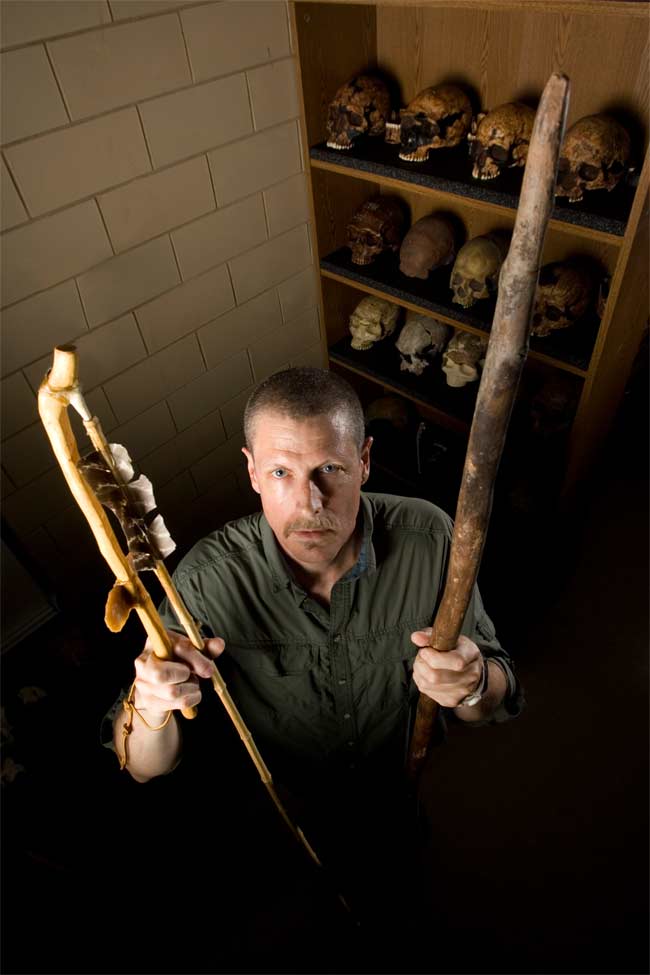Human Stabbed a Neanderthal, Evidence Suggests

Newly analyzed remains suggest that a modern human killed a Neanderthal man in what is now Iraq between 50,000 and 75,000 years ago. The finding is scant but tantalizing evidence for a theory that modern humans helped to kill off the Neanderthals.
The probable weapon of choice: A thrown spear.
The evidence: A lethal wound on the remains of a Neanderthal skeleton.
The victim: A 40- to 50-year-old male, now called Shanidar 3, with signs of arthritis and a sharp, deep slice in his left ninth rib.
"What we've got is a rib injury, with any number of scenarios that could explain it," said study researcher Steven Churchill, an associate professor of evolutionary anthropology at Duke University in North Carolina. "We're not suggesting there was a blitzkrieg, with modern humans marching across the land and executing the Neandertals [aka Neanderthals]. I want to say that loud and clear."
But he added, "We think the best explanation for this injury is a projectile weapon, and given who had those and who didn't, that implies at least one act of inter-species aggression."
(The words "Neanderthal" and "Neandertal" refer to the same species, Homo neanderthalensis, which lived on the plains of Europe and parts of Asia as far back as 230,000 years ago. They disappeared from the fossil record more than 20,000 years ago.)
Sign up for the Live Science daily newsletter now
Get the world’s most fascinating discoveries delivered straight to your inbox.
Violent past
Scientists are continuing to refine their understanding of early Homo sapiens and Neanderthals, with hopes of also resolving the mystery of how the latter species went extinct while we did not. Past research has yielded conflicting evidence on interbreeding between the two species, but the new study clearly shows the opposite of affection.
In fact, another Neanderthal skeleton dating back some 36,000 years and found in France showed signs of a scalp injury likely caused by a sharp object that may have been delivered by a modern human at the time, Churchill said.
"So if the Shanidar 3 case is also a case of inter-specific violence and if Shandiar 3 overlaps in time with modern humans, we're beginning to get a little bit of a pattern here," Churchill said.
Competition for resources with modern humans, along with other factors, may have also played a role in the die-off of Neanderthals, the researchers say.
Stab simulations
Churchill and his colleagues examined Shanidar 3, one of nine Neanderthals discovered between 1953 and 1960 in a cave in northeastern Iraq's Zagros Mountains. The team also ran experiments with a specially calibrated crossbow, which they used to deliver stone-pointed spears with different forces to simulate a thrusting spear and a long-range projectile weapon like a dart.
The weapons were thrust into pig and other animal carcasses. "Pigs make a pretty good model for Neandertal thoraces," Churchill told LiveScience. "The ribs are about the same stoutness and overall same size. And the musculature and skin thickness and things like that are pretty similar from what we can tell."
Then, the researchers compared the wounds created by the different scenarios, finding the thrusting spears did lots of damage, breaking multiple ribs.
"With the projectile weapon, even though it's traveling faster, it's a lot lighter and it tends to make distinct cut marks in the bones without injuring surrounding bones. That's like what we saw in Shanidar 3," Churchill said.
Cold case closed
The analyses also showed the Neanderthal's rib had started to heal before he died. By comparing the wound to medical records of injuries from the American Civil War, a time before modern antibiotics, the researchers figured the Neanderthal likely died within weeks of his injury, perhaps due to associated lung damage from a stabbing or piercing wound.
As for the spear, since modern humans had developed projectile hunting weapons and Neanderthals hadn't, the researchers deduced the probable suspect — a modern human.
Modern humans used spear throwers, detachable handles that connected with darts and spears to effectively lengthen a hurler's arm and give the missiles a power boost.
As human weapons technology advanced, Neanderthals continued using long thrusting spears in hunting, which they probably tried — for personal safety — to keep between themselves and their prey instead of hurling them, Churchill added.
In fact, one recent study suggested such Neanderthal hunting tools, including spear tips, were pretty sophisticated.
The new study, published online this week in the Journal of Human Evolution, was funded by the National Science Foundation, the L.S.B. Leakey Foundation and the University of New Mexico.
- Top 10 Missing Links
- More Neanderthal News & Information
- Neanderthals and Humans: Perhaps They Never Met
Jeanna Bryner is managing editor of Scientific American. Previously she was editor in chief of Live Science and, prior to that, an editor at Scholastic's Science World magazine. Bryner has an English degree from Salisbury University, a master's degree in biogeochemistry and environmental sciences from the University of Maryland and a graduate science journalism degree from New York University. She has worked as a biologist in Florida, where she monitored wetlands and did field surveys for endangered species, including the gorgeous Florida Scrub Jay. She also received an ocean sciences journalism fellowship from the Woods Hole Oceanographic Institution. She is a firm believer that science is for everyone and that just about everything can be viewed through the lens of science.
Why is yawning contagious?
Scientific consensus shows race is a human invention, not biological reality










